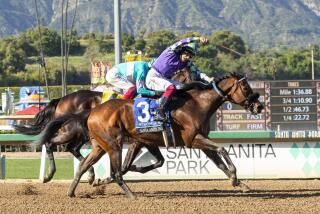HORSE RACING : He Wrote the Book on Training in Australia
SYDNEY, Australia — When Colin Hayes announced his retirement from the training profession, Australians thought a remarkable era had ended.
Hayes had compiled statistics that dwarf those of such venerable U.S. horsemen as Woody Stephens and Charlie Whittingham. He had trained the winners of 5,333 races. He had won 10 races in a single day, and had entered the “Guinness Book of World Records” by winning five stakes in a day.
Hayes turned over the management of his horses to his son David in August. The 28-year-old promptly erased one of his father’s records by winning six stakes in one memorable afternoon at Flemington Race Course in Melbourne. Then he shipped his top horse, Better Loosen Up, to Tokyo for the $2.6-million Japan Cup and captured a race richer than any his father had won. The feats proved the Hayes dynasty was based not simply on the skills of one man, but on a philosophy of training.
Colin Hayes had been an amateur jockey before he started training on a small scale, and he eventually established himself as the top trainer at the tracks in Adelaide. But even then he wasn’t satisfied. There must be a better way, he thought.
“We tend to do things in this sport the way our grandfathers did,” Hayes said. “But I had come into racing with no preconceived ideas, and I tried to be a horse psychologist. Horses are gregarious animals. They’re used to running in herds, not to living in jail. They prefer a natural setting (as opposed to the race-track environment). And in a rural setting you can give them a variety of places to work that will keep their interest.”
Racing people here thought it was slightly bizarre when Hayes bought rural property an hour north of Adelaide and moved his operation well away from any racing center. But under the ancient red gum trees at Lindsay Park he created a training center that combined rural tranquility with high-tech methodology. At his farm, horses exercise on treadmills, in swimming pools, on training tracks specially contoured to minimize stress and reduce breakdowns. Their workouts are timed by devices that use laser beams.
Hayes regularly employs interval training to get his horses fit. They gallop up a half-mile incline, then trot back down while the trainer measures their recovery rate--the time needed for the heartbeat to return to normal. They repeat the exercise three times, and the recovery rate enables Hayes to gauge their fitness.
Hayes’ methods made him the leading trainer in a nation in which the techniques of the profession already were very sophisticated. Major Australian stakes are commonly scheduled close together as part of so-called racing carnivals, and trainers must prepare their horses for several major efforts in a short period of time.
American horsemen who complain about the rigors of the Triple Crown series would marvel at what their Australian counterparts must do to win the Victoria Derby. Horses here generally run in two 1 1/4-mile stakes before running in the 1 9/16-mile Derby, with the races falling on consecutive Saturdays. It is the equivalent of scheduling the Triple Crown during a three-week period in late March and early April of a horse’s 3-year-old season. How do they do it?
“Our methods are different,” Hayes said. “There’s not as much speed training as in America, or as much emphasis on long, strenuous workouts. We do a lot of walking and trotting through the countryside. We save them for racing.”
And Hayes also argues that the horses here are sounder and tougher than they are in the rest of the world. “Our horses benefit from our rich limestone soil, from more hours of sunlight,” he said. “Veterinarians have told me that, generally speaking, horses here are sounder. It’s only because of our isolation that not many of our horses go on to the world scene and prove themselves in world competition like our swimmers, tennis players and golfers.”
Hayes single-handedly has done a great deal to show the world the virtues of the Australian thoroughbred. He is a savvy businessman as well as a horseman.
A journalist said: “He’s totally acceptable to kings, queens and prime ministers, but he’s got a streetwise business brain, and if he sells you a horse, he’ll get the last dollar out of you.”
Hayes got two of the world’s leading owners--Robert Sangster and Sheik Maktoum--involved in Australian racing, and rewarded their interest by winning a Melbourne Cup for each.
Hayes’ much-celebrated retirement wasn’t really a retirement. After being responsible for training as well as running the business aspects of Lindsay Park, he is now content to concentrate on business while David does the training.
“He’s fine-tuning the system. He’s an innovator,” the father said. “His horizons are widening, and he hopes one day to run horses in the Arc de Triomphe and the Breeders’ Cup.”
When that happens, the rest of the world may finally recognize the existence of one of the world’s most astute horsemen.
More to Read
Go beyond the scoreboard
Get the latest on L.A.'s teams in the daily Sports Report newsletter.
You may occasionally receive promotional content from the Los Angeles Times.










